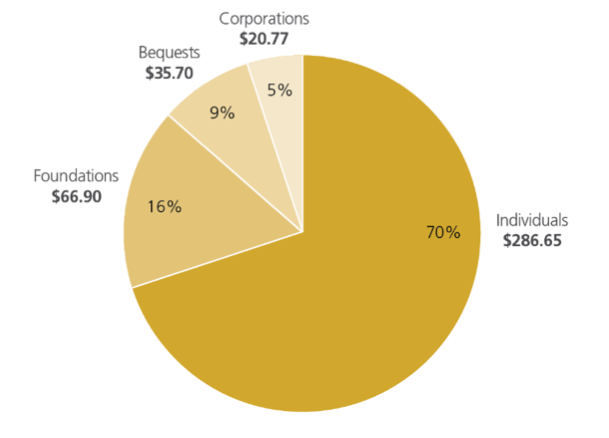Giving to tax-exempt organizations in the United States last year grew by more than 5 percent to $410.02 billion – eclipsing $400 billion for the first time ever – riding a wave of a strong stock market and the philanthropic response to a series of natural disasters.
Initial estimates for 2017 were released this morning as part of “Giving USA 2018: The Annual Report on Philanthropy for the year 2017,” published by Giving USA Foundation, a public service initiative of The Giving Institute. Researched and written by the Indiana University Lilly Family School of Philanthropy at IUPUI, the report is the longest-running and most comprehensive of its kind in America.
The 2018 report also revises downward the initial estimate on giving released a year ago for 2016, from $390.05 billion to $389.64 billion overall.
Each source of giving was up last year compared to 2016:
- Corporations, 8 percent (5.7 percent adjusted for inflation), $20.77 billion;
- Foundations, 6 percent (3.8 percent), $66.9 billion;
- Individual giving, 5.2 percent (3 percent), $286.65 billion; and,
- Bequests, 2.3 percent (0.2 percent), $35.7 billion.
Corporate giving was boosted by $405 million in contributions for relief related to natural and man-made disasters, such as Hurricanes Harvey, Irma and Maria, and wildfires in California.
Giving to all but one of the major types of recipient organizations grew in 2017:
- Foundations, 15.5 percent (13.1 percent), $45.89 billion;
- Arts, culture, humanities, 8.7 percent (6.5 percent), $19.51 billion;
- Public-society benefit, 7.8 percent (5.5 percent), $29.59 billion;
- Health, 7.3 percent (5.1 percent), $38.27 billion;
- Education, 6.2 percent (4.0 percent), $58.90 billion;
- Human services, 5.1 percent (2.9 percent), $50.06 billion;
- Religion, 2.9 percent (0.7 percent for inflation), $127.37 billion;
- International affairs, -4.4 percent (-6.4 percent), $22.97 billion.
 “The increase in giving in 2017 was generated in part by increases in the stock market, as evidenced by the nearly 20 percent growth in the S&P 500. Investment returns funded multiple very large gifts, most of which were given by individuals to their foundations, including two gifts of $1 billion or more,” Amir Pasic, Ph.D., the Eugene R. Tempel dean of the Lilly Family School of Philanthropy, said in a statement announcing the new estimates.
“The increase in giving in 2017 was generated in part by increases in the stock market, as evidenced by the nearly 20 percent growth in the S&P 500. Investment returns funded multiple very large gifts, most of which were given by individuals to their foundations, including two gifts of $1 billion or more,” Amir Pasic, Ph.D., the Eugene R. Tempel dean of the Lilly Family School of Philanthropy, said in a statement announcing the new estimates.
Overall giving tracked with the U.S. economy at about 2.1 percent of Gross Domestic Product (GDP), consistent with the past several years. It’s the fourth consecutive year giving has increased.
The huge increase in giving to foundations was the result of mega gifts from the likes of Facebook founder Mark Zuckerberg and his wife Priscilla Chan and Michael and Susan Dell. The decline in giving to international affairs was likely because many donors shifted their emphasis to support national and local disasters, said Una Osili, Ph.D., associate dean for research and international programs at the Lilly Family School of Philanthropy at Indiana University.
Contributions to donor-advised funds (DAF) are counted toward individual giving when the initial contribution is made while grants from DAFs to organizations are counted only when grants are made by DAFs held within community foundations. To reduce double counting, Giving USA takes the net incoming contributions and outgoing grants for other types of DAFs when calculating giving to recipient subsectors. DAFs fall either within the public-society benefit category, if they’re national commercial DAFs, or community foundations.
 Giving to international affairs tends to respond to big, international disasters, not driven by the economy. International disasters that drove growth during the past few years didn’t get the same level of media attention they did in the past, Osili said, but total giving in international affairs still was among the highest on record.
Giving to international affairs tends to respond to big, international disasters, not driven by the economy. International disasters that drove growth during the past few years didn’t get the same level of media attention they did in the past, Osili said, but total giving in international affairs still was among the highest on record.
Houston seems to have been the epicenter for charitable giving last year. Hurricane Harvey struck in August, flooding Houston and neighboring counties.
The United Way of Greater Houston raised more than $120 million last year, about $47 million in response to Harvey and $73 million for its annual campaign, which was down from the previous year. The organization received 26,000 gifts via email and text, much of it from around the nation and a good chunk from corporations. “We had 40 companies that had never given to United Way give to us or to disaster recovery,” CEO Anna Babin said.
In response to Hurricane Harvey, the state established the Rebuild Texas Fund, generating more than $94 million in donations, the Hurricane Harvey Relief Fund housed at the Greater Houston Community Foundation raised some $112 million, and Houston Texans football player drew $37 million via a crowdfunding campaign.
The United Way’s network also directed major supporters to Houston after Hurricane Harvey, she said, with more than 80 percent contributions coming from outside of Texas, including international gifts. Babin credited the Lilly Foundation’s largest gift, $5 million, to her relationship with the United Way CEO in Indianapolis, Ind.
Corporations sponsored matching employee campaigns and also shared United Way’s communications on the web and in email links. “It was really being creative and getting the message out. The campaign is the fuel to do community impact work,” Babin said.
The United Way of Greater Houston typically has more than 60 percent of its giving come from companies linked to the energy industry, which had seen layoffs in recent years because of the decline in oil prices. The restructuring within the local energy industry is what accounted for a $3 million decline in United Way’s annual campaign, Babin said. “So, what it says to us, in the next campaign, it’s how do you deepen relationships with new leadership in corporations and how keep them in path going upward and not down,” she said.
For all the good news about giving, the stiffest challenge for nonprofits might be one that they’ve been grappling with for years: retaining donors. And it’s still too early to tell just how much of an impact tax reform had on 2017 since legislation was passed just a few weeks before year’s end. The doubling of the standard deduction in 2018 is expected to reduce the number of taxpayers who itemize, which makes up a majority of charitable giving. The increased exemption on the estate tax also is expected to affect bequest giving.
“Looking ahead to 2018, we do expect donors to start to respond to the changes in the tax incentives available for charitable giving but it will take some time to fully assess what the impact of tax reform is likely be and how it affects different types of charities and different donor segments,” Osili said. Donors may choose to bunch their charitable giving in one single year rather than give small gifts over several years, she said.
For the most recent year that data are available (2015), the percentage of itemizers who reported giving to charity was 74 percent, according to Aggie Sweeney, chair of the Giving USA Foundation and senior counsel for Campbell & Company. With the doubling of the standard deduction as part of tax reform, the expectation is there will be fewer itemizers in 2018.
Only about 56 percent of households overall give charitable gifts. “The percentage is higher for those that itemize but participation in giving is at a level we hope will rebound with an economy that continues to be strong,” Sweeney said.
The trend of gifts getting larger continues but mega gifts were spread across different subsectors, Sweeney said. “It seems to have perhaps leveled out rather than the participation rate decreasing but it will be interesting to see what happens in the next year or two,” she said. Corporate giving as it relates to pre-tax profits was about 0.8 to 0.9 percent, Sweeney said, which doesn’t reach historic measures of more than 1 percent.
“While there could be economic times that may not be as positive in years to come, we already know significant funds are set aside for philanthropy,” Sweeney said, between donor-advised funds (DAF) and giving to foundations increasing steadily over the years. “It’s important for nonprofits to keep that in mind when they engage with prospective donors,” she said.
The Houston Food Bank received donations from all 50 states and 40 countries in response to Harvey, distributing three times the amount of food it normally does in September 2017.
“There were nonprofits that didn’t bother to raise money in September. Everyone was focused on Harvey. There was no point,” said Amy Ragan, chief development officer. In all, Houston Food Bank received some 6,800 donations, about 6,000 of which were less than $1,000. “People sent cards, notes, one person sent a check in a Ziploc baggie so it wouldn’t get wet,” she said.
“We needed those dollars that came in. Our regular fundraising, believe it or not, even though we’re a disaster response organization, was impacted by Harvey, and so we have taken hits on some of our direct mail campaigns and events,” Ragan said.
She expects the food bank to reach $21 million in fundraising, outside of Harvey, which totaled about $41 million from September to April. Some of that giving was a “Harvey effect” of increased awareness of the food bank after the storm but it’s unclear whether that will return next year, she said.
The United Way of the Wine Country in Santa Rosa, Calif., is normally a $3-million organization but after last year’s wildfires, it expects to reach about $11 million, with almost $8 million for wildfires, according to Jennifer O’Donnell, vice president, community benefit, and interim president/CEO. About $6 million has been spent on short-term relief, with the rest carried over to the next fiscal year and earmarked for mid- and long-term recovery.
“The majority of funding comes in right away but problems continue for a long time,” she said. United Way awarded some 6,000 grants directly to people who lost their home, job, or were directly impact somehow.
“It looks rosy because it’s a lot more money,” O’Donnell said but local funders lost homes to wildfires and local companies decided not to run fundraising campaigns in the midst of the wildfires. “The wildfires hit pretty indiscriminately – low-income and middle-class as well as wealthy neighborhoods – large donors lost homes, we don’t know how long it will take to come back as donors,” she said.
There were generally optimistic trends in terms of donations, before the wildfires, according to O’Donnell, but then 5,300 homes were lost so it’s kind of uncertain. With so much focus on the wildfires, United Way also couldn’t devote resources to grant writing, another concern for next year, she added.










